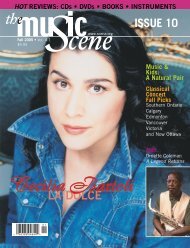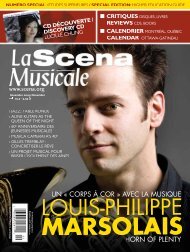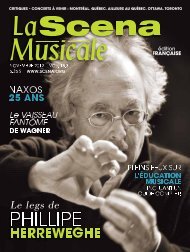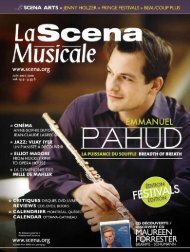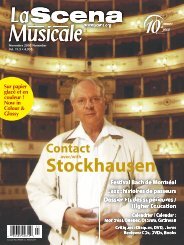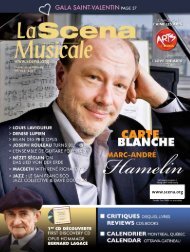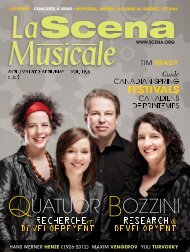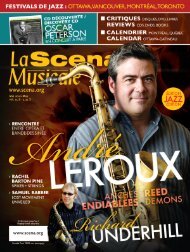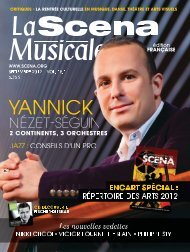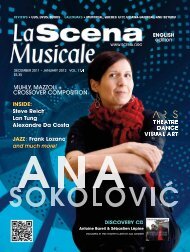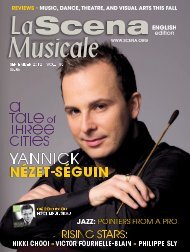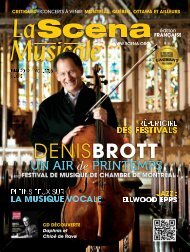Adobe Acrobat PDF complet (6 Meg) - La Scena Musicale
Adobe Acrobat PDF complet (6 Meg) - La Scena Musicale
Adobe Acrobat PDF complet (6 Meg) - La Scena Musicale
You also want an ePaper? Increase the reach of your titles
YUMPU automatically turns print PDFs into web optimized ePapers that Google loves.
Paul E. Robinson<br />
When I was a young<br />
music student growing<br />
up in Toronto in the<br />
1950s, the music of Anton Bruckner<br />
was alien territory. The problem was<br />
that it was rarely performed, and<br />
everything about his music—the<br />
melodies, the movements and the<br />
symphonies—was too long.<br />
Furthermore, the music seemed to<br />
be continually stopping and starting.<br />
Of course the real problem with<br />
Bruckner was me; I was too young<br />
and immature to appreciate it.<br />
Enlightenment began with a<br />
recording of the Fourth Symphony<br />
by Steinberg and the Pittsburg<br />
Symphony. I loved the horn fanfares<br />
in the scherzo and the massive<br />
sounds from the brass section. A<br />
live performance on November 17,<br />
1959, at Carnegie Hall of the Eighth<br />
Symphony by Karajan and the<br />
Vienna Philharmonic cemented my<br />
UNDERSTANDING<br />
BRUCKNER<br />
appreciation. Karajan’s hypnotic conducting was<br />
just what the music required. Right from the mysterious<br />
opening bars, through the searing trumpet<br />
calls, the otherworldly Adagio, the hair-raising<br />
march opening the last movement, and right<br />
through to its triumphant conclusion, I was under<br />
Bruckner’s spell. In the final pages, Bruckner, a<br />
master contrapuntalist, combines themes from all<br />
four movements of the symphony in a magnificent<br />
ments were in sacred choral music—above all the<br />
Te Deum and the Mass in F minor—and in symphonic<br />
music. Bruckner wrote 11 symphonies, but<br />
he didn’t consider the unnumbered Symphony in F<br />
minor and the Symphony No. 0 in D minor on the<br />
same level as his later, numbered symphonies.<br />
The remaining nine symphonies are all glorious<br />
pieces but some of them exist in various editions<br />
and versions. This is a minefield for conduc-<br />
peroration. I felt as if I had lived a lifetime in tors trying to determine Bruckner’s real<br />
the 85 minutes it took to perform this great<br />
symphony.<br />
Some detractors have dismissed Bruckner as a<br />
country bumpkin, an Austrian peasant, a mere<br />
church organist and much worse. It is true that<br />
he spent much of his life in small, rural communities<br />
near Linz, that for much of his career he<br />
was a teacher and church organist, and that he<br />
intentions and final thoughts. The problem was<br />
that Bruckner was insecure about the value of his<br />
work; bad reviews often drove him to months of<br />
rewriting, and friends and acolytes could all too<br />
easily persuade him to make ‘improvements.’ The<br />
Bruckner Problem, as some scholars have called<br />
it, involves sorting out what is really Bruckner<br />
and what is not. You can read more about it in<br />
was a devout Catholic who even kept a daily written<br />
Deryck Cooke’s “The Bruckner Problem<br />
record of his prayers. But it is also true that he<br />
taught at the University of Vienna, attended the<br />
premieres of all the works of Wagner’s maturity<br />
in Bayreuth, and gave organ recitals at the Royal<br />
Albert Hall and the Crystal Palace in London.<br />
Bruckner may not have been a ‘man of the world’<br />
but in his mature years he was widely recognized<br />
as a fine and beloved teacher, an organist<br />
renowned for his improvisational skills and an<br />
important composer<br />
For a major composer, his output was surprisingly<br />
small and he wrote almost nothing of significance<br />
for his own instrument. His great achieve-<br />
Simplified”, first published by The Musical Times<br />
in 1969 and also included in a compilation of<br />
Cooke’s articles under the title Vindications<br />
(Cambridge: Cambridge University Press, 1982),<br />
and Hans-Hubert Schönzeler’s Bruckner (New<br />
York: Vienna House, 1978).<br />
Bruckner’s music is profoundly expressive in<br />
its slow movements, joyous in its scherzos and<br />
magnificent in its climaxes. There is nothing<br />
quite like it. And yet in hindsight it can be seen to<br />
grow naturally from what came before. All the<br />
qualities I have attributed to Bruckner, including<br />
length of melodies and movements, can be found<br />
in embryonic form in Schubert’s “Great”<br />
Symphony No. 9 in C major. Some of Franz<br />
<strong>La</strong>chner’s later symphonies and<br />
Mendelssohn’s “Lobgesang” and<br />
“Reformation” symphonies could also be<br />
described as Brucknerian. The point is that<br />
Bruckner grew out of the mainstream of<br />
German Romantic music to become one of<br />
its greatest symphonic exponents.<br />
Bruckner was a product of his musical<br />
training and the culture in which he lived.<br />
But his profound Catholic faith also found<br />
expression in his music. This is not only true<br />
of the liturgical works but also of his symphonies.<br />
Does this mean that one must be a<br />
Catholic to appreciate his music? In his BBC<br />
booklet Bruckner and the Symphony Robert<br />
Simpson gave a persuasive answer to this<br />
question: the religious elements and the<br />
characteristically Austrian tone in much of<br />
Bruckner’s music have sometimes been<br />
quoted as barriers to his acceptance by non-<br />
Catholics and foreigners. This is false counsel;<br />
one need not be Austrian or Catholic (or<br />
even religious) to find one’s imagination<br />
stirred by the vast power and sweep of<br />
Bruckner’s greatest music. Majesty is a quality<br />
eminently recognizable in itself.<br />
BRUCKNER IN CANADA<br />
Yannick Nézet-Séguin has become our<br />
Bruckner man in Montreal and is intent on<br />
recording all the symphonies with the<br />
Orchestre Métropolitain. Released so far<br />
are the Seventh and Ninth symphonies on ATMA.<br />
Meanwhile with the Toronto Symphony, Peter<br />
Oundjian has entered the Bruckner sweepstakes<br />
with the Symphony No. 4 on the orchestra’s own<br />
label, TSO Live. Although Kent Nagano is a recognized<br />
Brucknerian in Europe, he has yet to bring<br />
this to Canadian audiences.<br />
BRUCKNER FOR THE AGES<br />
There have been many fine Bruckner recordings<br />
made over the years: Furtwängler, Karajan, Wand,<br />
Jochum, Böhm and Giulini come to mind. But there<br />
are several recordings that would provide the neophyte<br />
with a formidable introduction. The first is a<br />
2-DVD set issued just last year by Deutsche<br />
Grammophon. It contains Symphonies 8 and 9 and<br />
the Te Deum conducted by Karajan in live performances<br />
with the Vienna Philharmonic from the late<br />
1970s. Each of the performances is spellbinding<br />
from beginning to end but the Eighth is in a special<br />
category altogether. It was given in St. Florian, the<br />
church near Linz where Bruckner lived and worked<br />
for many years.The composer is buried in the crypt<br />
beneath the great organ there.<br />
The other recordings are part of a 4-DVD set by<br />
Decca under the title Sir Georg Solti: the Maestro.<br />
Solti and the Chicago Symphony at the very peak of<br />
their relationship in 1978-79, giving stunning performances<br />
of the Sixth and Seventh symphonies,<br />
the latter while on tour at the Royal Albert Hall. ■<br />
12 Juin 2009 June



